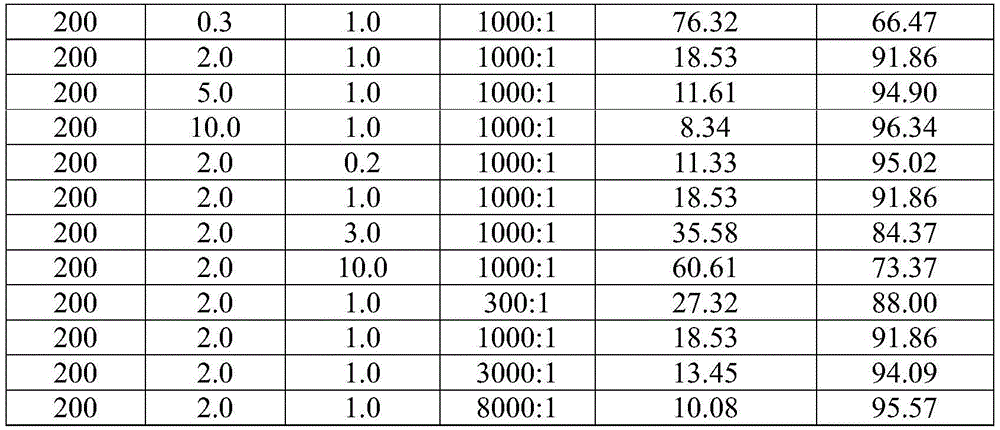Method for lowering bromine index of linear alkylbenzene
A technology of linear alkylbenzene and bromine index, which is applied in chemical instruments and methods, purification/separation of hydrocarbons, hydrocarbons, etc., and can solve problems such as environmental pollution and large loss of linear alkylbenzene
- Summary
- Abstract
- Description
- Claims
- Application Information
AI Technical Summary
Problems solved by technology
Method used
Image
Examples
Embodiment 1
[0037] Example 1: 0.2%Pt-0.4%Sn / SiO 2 Catalyst preparation
[0038] Weigh 10g of porous silica gel carrier (its specific surface area is 480m 2 / g). From 0.0531g (1.0253×10 -4 mol) chloroplatinic acid and 2% hydrochloric acid aqueous solution with a mass fraction of HCl to prepare 6 mL of solution A. From 0.1181g (3.3685×10 -4 mol) of tin tetrachloride and 2% HCl aqueous hydrochloric acid solution to prepare 6 mL of solution B. Under nitrogen protection, stirring, and room temperature, slowly add solution B to solution A to form a 12mL impregnation solution. The concentrations of chloroplatinic acid and tin tetrachloride in the impregnation solution are 8.5441×10 -6 mol / mL and 2.8071×10 -5 mol / mL, the volume of the impregnating solution is equal to the volume of the maximum adsorbed water of the catalyst carrier; add 12mL of the impregnating solution dropwise to 10g of silica gel while stirring, and let stand for 2h after the dropwise addition; then, dry at 80°C for 24h, ...
Embodiment 2
[0039] Example 2: 0.5%Pt-0.5%Sn / SiO 2 Catalyst preparation
[0040] Weigh 10 g of the porous silica gel carrier. By 0.1327g (2.5623×10 -4 mol) chloroplatinic acid and 5% HCl aqueous hydrochloric acid solution to prepare 6 mL of solution A. By 0.1477g (4.2128×10 -4 mol) tin tetrachloride and 5% hydrochloric acid aqueous solution with a HCl mass fraction of 6 mL solution B. Under nitrogen protection, stirring, and room temperature, slowly add solution B to solution A to form a 12mL impregnation solution. The concentrations of chloroplatinic acid and tin tetrachloride in the impregnation solution are 2.1352×10 -5 mol / mL and 3.5106×10 -5 mol / mL, the volume of the impregnating solution is equal to the volume of the maximum adsorbed water of the catalyst carrier; add 12mL of the impregnating solution dropwise to 10g of silica gel while stirring, and let stand for 10h after the dropwise addition; then, dry at 100°C for 2h, Programmable heating at a rate of 1 / min to 600°C, const...
Embodiment 3
[0041] Example 3: 1%Pt-0.5%Sn / SiO 2 Catalyst preparation
[0042] Weigh 10 g of the porous silica gel carrier. By 0.2654g (5.1246×10 -4 mol) chloroplatinic acid and HCl aqueous hydrochloric acid solution with a mass fraction of 10% prepare 6 mL of solution A. By 0.1477g (4.2128×10 -4 mol) tin tetrachloride and HCl aqueous hydrochloric acid solution with a mass fraction of 10% prepare 6 mL of solution B. Under the condition of nitrogen protection, stirring and room temperature, solution B was slowly added dropwise to solution A to form 12mL impregnation solution. The concentration of chloroplatinic acid and tin tetrachloride in the impregnation solution were 4.2704×10 -5 mol / mL and 3.5106×10 -5 mol / mL, the volume of the impregnating solution is equal to the volume of the maximum adsorbed water of the catalyst carrier; add 12mL of the impregnating solution dropwise to 10g of silica gel while stirring, and let stand for 24h after the dropwise addition; then, dry at 80°C for ...
PUM
| Property | Measurement | Unit |
|---|---|---|
| bromine number | aaaaa | aaaaa |
Abstract
Description
Claims
Application Information
 Login to View More
Login to View More - R&D
- Intellectual Property
- Life Sciences
- Materials
- Tech Scout
- Unparalleled Data Quality
- Higher Quality Content
- 60% Fewer Hallucinations
Browse by: Latest US Patents, China's latest patents, Technical Efficacy Thesaurus, Application Domain, Technology Topic, Popular Technical Reports.
© 2025 PatSnap. All rights reserved.Legal|Privacy policy|Modern Slavery Act Transparency Statement|Sitemap|About US| Contact US: help@patsnap.com



